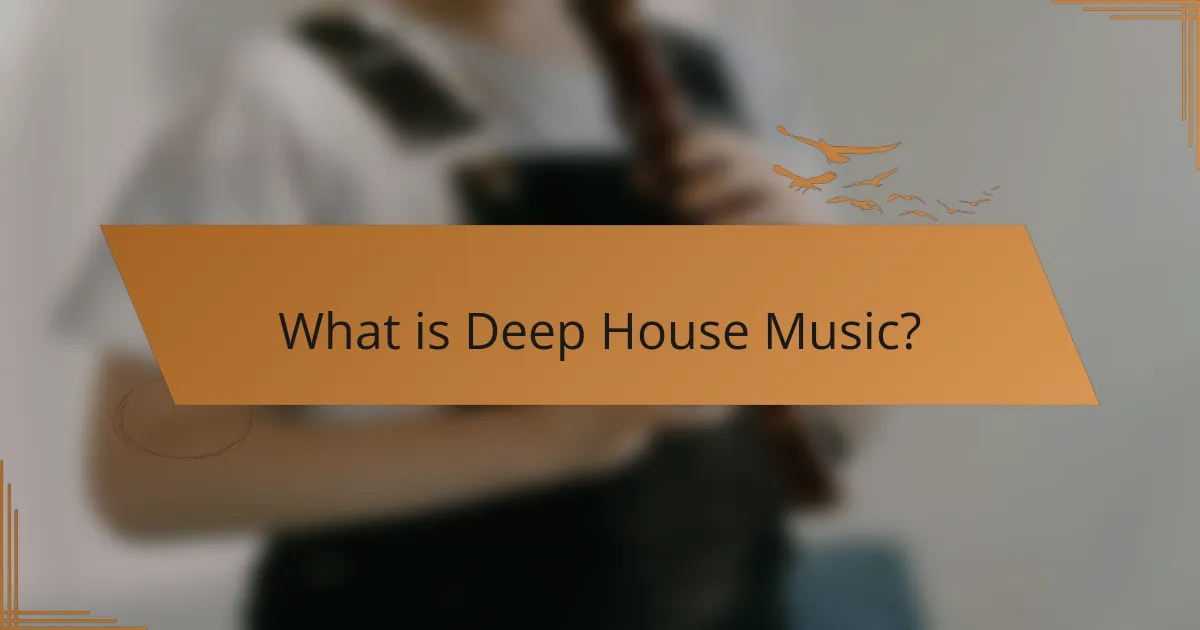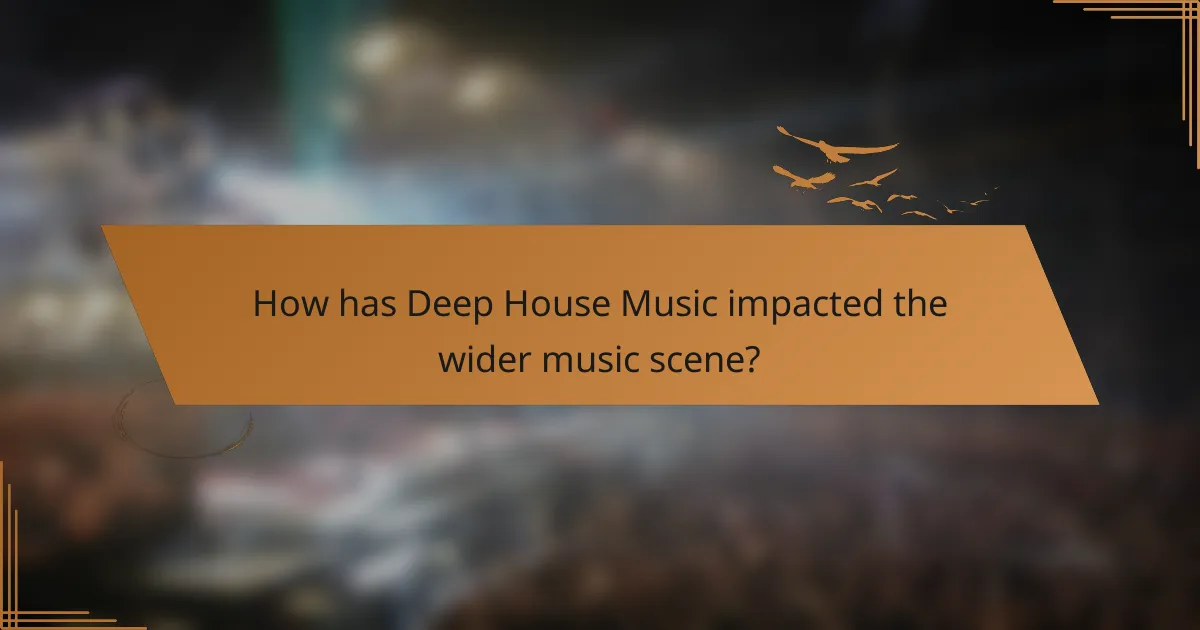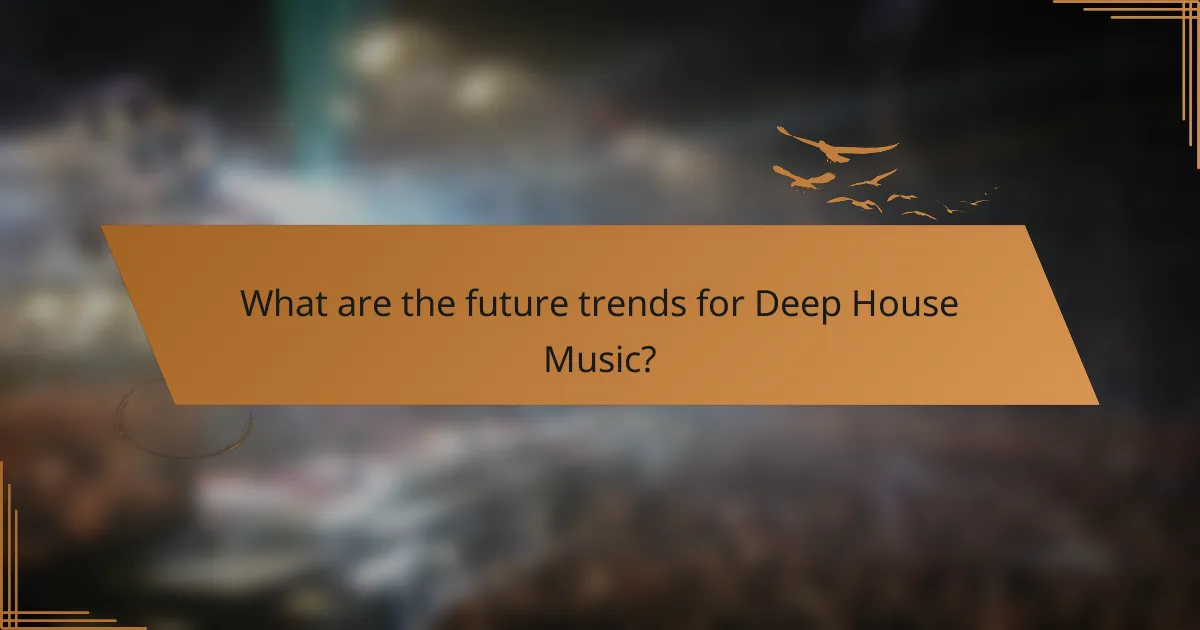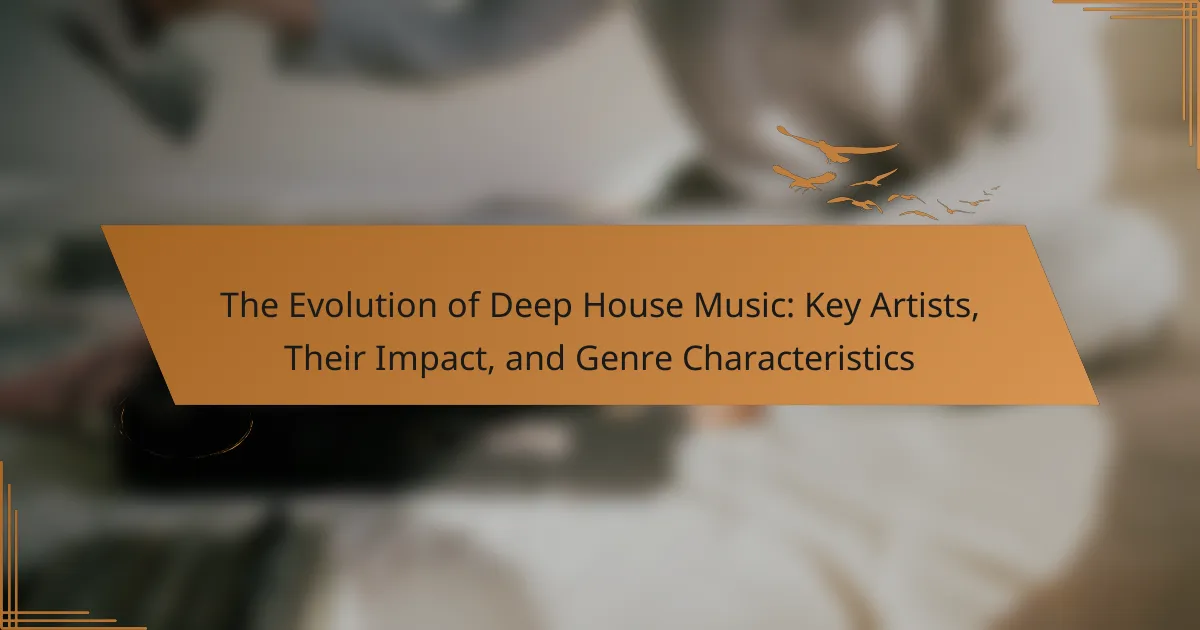Deep house music is a subgenre of house music known for its complex melodies and soulful vocals, emerging in the 1980s with roots in jazz, funk, and soul. Key artists such as Larry Heard and Kerri Chandler have significantly influenced the genre, which features slower tempos and elements like atmospheric pads and deep basslines. This article explores the evolution of deep house music, highlighting its impact on the broader music scene, its role in shaping electronic dance music (EDM), and the future trends driven by technology, collaborations, and sustainability. The discussion includes the genre’s contributions to mainstream acceptance and its integration into various musical styles.

What is Deep House Music?
Deep house music is a subgenre of house music characterized by its complex melodies and soulful vocals. It emerged in the 1980s, influenced by jazz, funk, and soul music. The genre typically features slower tempos, often between 110 and 125 beats per minute. Deep house music often incorporates elements like atmospheric pads, deep basslines, and intricate percussion. Notable artists such as Larry Heard and Kerri Chandler played significant roles in shaping the genre. The sound is often described as emotive and immersive, appealing to both dance and listening audiences. Deep house has gained popularity in clubs and festivals worldwide, showcasing its enduring influence in electronic music.
How did Deep House Music originate?
Deep House Music originated in the 1980s as a subgenre of house music. It combines elements of Chicago house with jazz, soul, and funk influences. Pioneers like Larry Heard and Frankie Knuckles played crucial roles in its development. The genre is characterized by its use of complex chords and a slower tempo. Deep house often features smooth, soulful vocals and atmospheric sounds. The term “deep” reflects the genre’s emotional depth and rich musicality. Its popularity grew in the 1990s and continues to influence contemporary electronic music. The genre has a dedicated following and remains significant in club culture today.
What are the key influences that shaped Deep House Music?
Deep House Music was shaped by various key influences, including Chicago house, jazz, soul, and funk. Chicago house laid the foundational rhythm and structure for the genre in the 1980s. Jazz elements contributed to the complex chords and improvisational aspects found in deep house tracks. Soul music infused emotional depth and vocal styles that became signature features. Funk provided the groove and basslines that drive many deep house songs. Additionally, the use of synthesizers and drum machines from the electronic music scene further defined the sound. These influences collectively created a genre that emphasizes mood and atmosphere, distinguishing it from other house music styles.
How did the Chicago House scene contribute to its evolution?
The Chicago House scene significantly contributed to the evolution of deep house music. It emerged in the early 1980s, characterized by its rhythmic beats and soulful melodies. Pioneers like Frankie Knuckles and Larry Heard shaped the sound with their innovative production techniques. The scene blended disco, funk, and electronic elements, creating a unique musical landscape. Chicago’s underground clubs became incubators for this new genre, fostering creativity and collaboration among artists. The widespread popularity of house music in Chicago influenced global music trends. This laid the groundwork for the development of deeper, more complex sub-genres like deep house. The legacy of the Chicago House scene remains evident in contemporary electronic music.
What are the defining characteristics of Deep House Music?
Deep House Music is characterized by its smooth, soulful sound and deep bass lines. It typically features slower tempos, usually ranging from 120 to 125 BPM. The genre often incorporates elements of jazz, funk, and soul. Vocals in Deep House are usually soft and melodic, enhancing its atmospheric quality. Additionally, the use of lush synth pads and ambient sounds creates a rich audio texture. The genre emerged in the 1980s, influenced by Chicago house music. Prominent artists like Larry Heard and Kerri Chandler helped define its sound. Deep House has gained popularity in clubs and festivals worldwide, showcasing its broad appeal.
What are the common musical elements found in Deep House tracks?
Deep House tracks commonly feature a steady four-on-the-floor beat. This rhythmic foundation provides a consistent danceable groove. Another element is the use of deep basslines, which create a rich, warm sound. Melodic elements often include jazzy chords and soulful vocals. These vocals typically have an emotive quality, enhancing the track’s atmosphere. Synth pads are frequently used to add texture and depth. The tempo of Deep House usually ranges between 120 to 125 BPM. Lastly, samples from various genres, including jazz and funk, are often incorporated to enrich the sound.
How does Deep House differ from other house genres?
Deep House differs from other house genres primarily through its emphasis on complex melodies and soulful vocals. This genre features a slower tempo, typically between 120 to 125 BPM, which contrasts with the faster beats found in genres like Tech House or Electro House. Deep House incorporates elements of jazz, funk, and ambient music, creating a more atmospheric sound.
The use of deep basslines and lush synths further distinguishes it from other house styles. Unlike Progressive House, which focuses on build-ups and drops, Deep House maintains a more relaxed vibe throughout. Additionally, the production techniques often include a greater focus on reverb and echo effects, enhancing the immersive experience.
Historically, Deep House emerged in the 1980s, influenced by pioneers like Larry Heard and Frankie Knuckles, who blended house music with soulful and jazz elements. This historical context supports its unique characteristics compared to other house genres.
What role do key artists play in the evolution of Deep House Music?
Key artists play a crucial role in the evolution of Deep House Music. They shape the genre through innovative sounds and production techniques. Pioneers like Larry Heard and Kerri Chandler introduced deep basslines and soulful melodies. Their unique styles influenced subsequent artists and trends within the genre. Collaborations among key artists fostered the blending of genres, expanding Deep House’s reach. Events and festivals featuring these artists helped popularize the genre globally. Additionally, their presence on streaming platforms increased accessibility for new listeners. Overall, key artists are instrumental in defining and transforming Deep House Music over time.
Who are the pioneering artists in Deep House Music?
Pioneering artists in Deep House Music include Larry Heard, Frankie Knuckles, and Kerri Chandler. Larry Heard, known as Mr. Fingers, is credited with producing some of the earliest deep house tracks in the 1980s. Frankie Knuckles, often referred to as the “Godfather of House,” played a significant role in popularizing the genre. Kerri Chandler is recognized for his soulful, melodic approach to deep house music. These artists laid the foundation for the genre, influencing countless musicians and shaping its sound. Their contributions are essential to understanding the evolution of deep house music.
What contributions did these artists make to the genre?
These artists significantly shaped the deep house genre through innovative sounds and techniques. They incorporated soulful melodies and complex chord progressions, creating a distinct emotional depth. Their use of samples from jazz and funk added richness to the music. Artists like Larry Heard pioneered the use of electronic instruments, influencing production styles. Others, such as Kerri Chandler, emphasized live instrumentation, enhancing the genre’s organic feel. The blending of house beats with atmospheric elements became a hallmark of deep house. Their contributions established a foundation for contemporary artists in the genre. This evolution has led to a diverse range of sub-genres and styles within deep house music.

How has Deep House Music impacted the wider music scene?
Deep House Music has significantly influenced the wider music scene by popularizing a blend of soulful melodies and electronic beats. This genre emerged in the 1980s, rooted in Chicago house music, and has since evolved to incorporate various styles. It has contributed to the rise of electronic dance music (EDM), shaping festival lineups and club culture globally. Key artists like Larry Heard and Kerri Chandler have set standards for production quality and emotional depth in music. The genre has also led to the mainstream acceptance of house music, evident in charts and radio play. Collaborations between deep house artists and mainstream pop musicians have further bridged gaps between genres. This cross-pollination has resulted in a wider audience for electronic music as a whole. The incorporation of deep house elements in pop, hip-hop, and R&B tracks demonstrates its far-reaching influence. Overall, deep house music has redefined modern music landscapes, making it a pivotal force in contemporary music evolution.
What influence has Deep House had on other genres?
Deep House has significantly influenced various electronic music genres. Its characteristics, such as smooth basslines and soulful vocals, have been integrated into genres like Tech House and Chillout. The genre’s emphasis on atmosphere and groove has shaped the development of Future House and Progressive House. Artists like Disclosure and Kaytranada have blended Deep House elements into mainstream pop, expanding its reach. The genre’s impact is evident in the rise of sub-genres that prioritize emotional depth and musicality. Additionally, Deep House has influenced the resurgence of vinyl and analog sounds in contemporary electronic music.
How has Deep House Music been integrated into pop culture?
Deep house music has been integrated into pop culture through its presence in mainstream media and collaborations with popular artists. The genre has influenced various music charts and playlists. Notable tracks have sampled deep house elements, making them accessible to wider audiences. Artists like Drake and Dua Lipa have incorporated deep house sounds into their hits. Festivals and clubs frequently feature deep house DJs, enhancing its visibility. Additionally, deep house has been featured in films and commercials, further embedding it in popular culture. The genre’s smooth beats and soulful vocals resonate with listeners, contributing to its popularity.
What collaborations have emerged between Deep House artists and other genres?
Deep House artists have collaborated with various genres, including pop, hip-hop, and techno. A notable collaboration is the track “I Feel for You” by Bob Sinclar, which blends Deep House with disco elements. Another example is “Dancing On My Own” remixed by Robyn, showcasing a fusion of Deep House and pop. Additionally, the artist Lane 8 has worked with vocalists from indie and folk backgrounds, merging Deep House with singer-songwriter styles. These collaborations expand the reach of Deep House and introduce it to diverse audiences.
How has the audience for Deep House Music changed over time?
The audience for Deep House Music has evolved significantly over the years. Initially, it attracted a niche group of underground music enthusiasts in the 1980s and 1990s. This audience primarily consisted of club-goers and DJs who appreciated its unique sound. As the genre gained popularity, it expanded to include a broader demographic in the 2000s. The rise of digital streaming platforms contributed to this growth. Younger listeners began discovering Deep House through playlists and social media. Festivals and mainstream events also introduced the genre to diverse audiences. Today, Deep House appeals to a wide range of age groups and cultural backgrounds. This shift reflects its integration into popular music and mainstream culture.
What demographics are most engaged with Deep House Music today?
Young adults aged 18 to 34 are the most engaged demographic with Deep House Music today. This age group shows a strong preference for electronic music genres. According to a 2021 survey by Statista, 41% of electronic music listeners are within this age range. Additionally, urban areas with vibrant nightlife contribute to the popularity of Deep House among this demographic. Events like music festivals and club nights often feature Deep House artists, attracting younger audiences. Social media platforms also play a significant role in promoting Deep House Music to this age group. As a result, the engagement levels remain high, driven by both cultural trends and technological access.
How has the rise of streaming platforms affected Deep House Music’s reach?
The rise of streaming platforms has significantly expanded Deep House Music’s reach. Streaming services like Spotify and Apple Music have made the genre more accessible to global audiences. This accessibility allows listeners to discover new artists and tracks easily. In 2020, Deep House saw a 23% increase in streams on Spotify alone. The algorithms used by these platforms promote Deep House tracks based on user preferences. This exposure leads to increased visibility for both established and emerging artists. Consequently, Deep House has gained a more diverse listener base. The genre has also started appearing in various playlists, further enhancing its reach.

What are the future trends for Deep House Music?
The future trends for Deep House Music include increased integration of technology and live performances. Artists are increasingly using AI tools to create innovative sounds. This trend enhances the creative process and introduces new sonic possibilities. Collaborations between genres are also expected to rise. Deep House will likely blend more with elements from techno, pop, and even hip-hop.
The emergence of virtual reality experiences is another trend. This allows fans to engage with music in immersive environments. Additionally, the focus on sustainability in music festivals will influence Deep House events. Artists may prioritize eco-friendly practices in their performances. The growth of streaming platforms will continue to shape how Deep House is consumed. This will lead to more diverse audiences and global reach.
Overall, Deep House is set to evolve through technology, collaboration, and sustainability.
How is technology shaping the production of Deep House Music?
Technology is significantly shaping the production of Deep House Music. Digital audio workstations (DAWs) allow producers to create, edit, and mix tracks with precision. Software synthesizers provide a wide range of sounds that define the genre’s signature style. MIDI controllers enable real-time manipulation of music elements, enhancing creativity. Sampling technology allows artists to incorporate diverse sounds and influences seamlessly. The rise of online collaboration tools facilitates global partnerships among producers. Streaming platforms have changed how music is distributed and consumed, impacting production choices. Additionally, advancements in sound engineering techniques improve overall audio quality. These technological developments have transformed Deep House Music into a more accessible and innovative genre.
What tools and software are popular among Deep House producers?
Deep House producers commonly use tools and software like Ableton Live, FL Studio, and Logic Pro. Ableton Live is favored for its intuitive interface and live performance capabilities. FL Studio is popular for its powerful sequencing and editing features. Logic Pro is known for its extensive library of sounds and plugins. Additionally, many producers utilize VST plugins such as Serum and Massive for sound design. These tools allow for the creation of rich, layered sounds typical in Deep House music. The choice of software often depends on personal preference and workflow.
How does the use of social media influence the promotion of Deep House Music?
Social media significantly influences the promotion of Deep House Music. It provides a platform for artists to share their work directly with fans. This direct engagement fosters a community around the genre. Social media channels like Instagram, Facebook, and TikTok allow for visual and audio content sharing. Artists can showcase new tracks, live performances, and behind-the-scenes content. According to a 2021 survey by the International Music Summit, 80% of electronic music fans discover new music through social media. This statistic highlights the importance of these platforms in reaching new audiences. Additionally, social media enables targeted advertising to specific demographics interested in Deep House Music. This targeted approach increases the effectiveness of promotional efforts.
What tips can aspiring artists follow to succeed in Deep House Music?
Aspiring artists can succeed in Deep House Music by focusing on a few key strategies. First, they should develop a unique sound that reflects their personal style. This can be achieved by experimenting with different instruments and production techniques. Second, networking with other artists and industry professionals is essential. Building relationships can lead to collaborations and opportunities. Third, consistent practice and honing their craft are crucial. Regularly creating and refining tracks will enhance their skills.
Additionally, artists should stay informed about current trends in the genre. Following influential Deep House artists and attending events can provide inspiration and insight. Lastly, promoting their music through social media and streaming platforms can increase visibility. Engaging with fans and creating a brand identity will help in building a loyal audience.
What skills should new producers focus on developing?
New producers should focus on developing technical skills, creativity, and industry knowledge. Technical skills include proficiency in digital audio workstations (DAWs) and sound design. Mastering these tools is essential for producing high-quality tracks. Creativity involves understanding musical composition and arrangement. This skill allows producers to create unique sounds and styles. Industry knowledge includes networking and marketing strategies. Understanding the music business helps producers promote their work effectively. These skills are critical for success in the competitive deep house music scene.
How can artists effectively market their Deep House tracks?
Artists can effectively market their Deep House tracks by utilizing social media platforms. Social media allows direct engagement with fans and promotes new releases. Platforms like Instagram and TikTok are particularly effective for music promotion. Artists can create engaging content, such as behind-the-scenes videos or live performances. Collaborating with influencers can also expand reach and visibility. Additionally, submitting tracks to online music blogs and playlists increases exposure. According to a 2021 report by the International Federation of the Phonographic Industry, social media is a key driver for music discovery among listeners. Engaging with fans through live streaming can further enhance connection and interest.
Deep house music is a subgenre of house music that emerged in the 1980s, characterized by complex melodies, soulful vocals, and slower tempos typically between 110 and 125 BPM. Influenced by jazz, funk, and Chicago house, deep house features elements such as deep basslines, atmospheric pads, and intricate percussion. Key artists like Larry Heard and Kerri Chandler have significantly shaped the genre, contributing to its emotional depth and immersive sound. The article will explore the origins, defining characteristics, and influential artists of deep house music, as well as its impact on the wider music scene and future trends within the genre.
